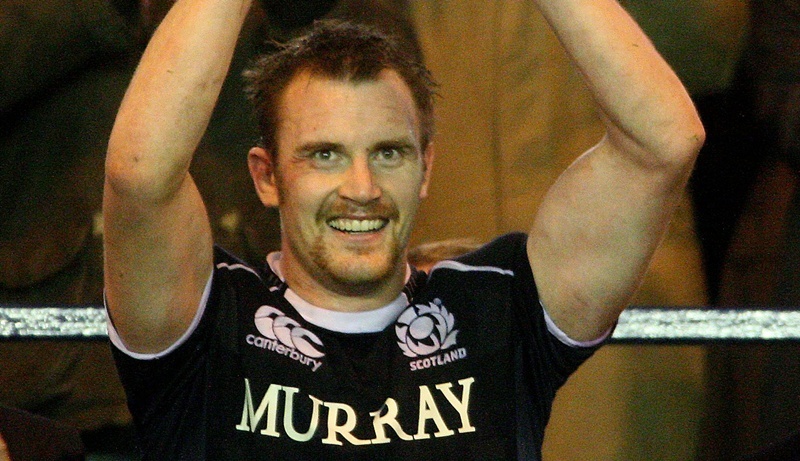Scotland made their 2011 RBS Six Nations look partly respectable and avoided the wooden spoon with a professional victory over Italy at Murrayfield on Saturday.
But the overriding frustration is that it took the whole championship to get the team back to where they started.
Pre-championship optimism appears an endemic complaint among Scots players, supporters and journalists alike but this year’s came on the back of a strong final 10 months of last year, when only a rampant New Zealand could beat Scotland in seven outings.
The games against Wales and Ireland, targeted as wins, produced substandard displays and it was only in Saturday’s second 40 minutes, their best and most complete performance of the championship, that Scotland looked like the team that beat South Africa and Argentina and were outside shots at the title before the Six Nations began.
Head coach Andy Robinson conceded his side had gone backwards in some areas in the last seven weeks after the ultimately comfortable 21-8 win over Italy, pinpointing defensive errors giving up cheap tries, set-piece inconsistency and a failure to take chances old failings familiar to anyone who has watched Scotland in the 21st century.
To put Saturday aside first, these were solved in part. The defensive lapse that allowed Andrea Masi an easy run for Italy’s early try came from Nikki Walker, a late insertion into the team, not getting in position properly.
But there were few lapses thereafter, Chris Paterson’s brilliant cover tackle on Luke McLean being the only real heart-stopping moment and that coming with only three minutes remaining.
The set-piece was so many notches up from Twickenham that it could not be measured.
The first four Italian line-outs were stolen and they were never able to set up their preferred mauling game as a result, while the scrum got the shove on as the front row continually got the hit ahead of their counterparts.Robinson moulding teamChance-taking improved, with tries for Nick De Luca and Walker -the first scored at Murrayfield by Scotland since Fiji in November 2009 and the first in the championship there since Italy were last in Edinburgh two years ago but they left three or four glaring chances on the paddock and one still wouldn’t confuse this Scottish side with a truly ruthless international outfit.
Two moments served to undermine the Italians, the first being the injury to Masi that robbed them of their best attacking threat, the second when they came out for the second half looking to increase their 8-6 lead but were repulsed by excellent defence as Gonzalo Canale dropped the ball and after Sean Lamont hacked up field.
The centre missed the immediate scoring chance but the Scotland side had the field position they finally exploited for De Luca’s debut test try.
With no games now until August’s return of Ireland and Italy for World Cup warm-up games, there’s not much scope for further development.
But in truth one could argue that Robinson has done that already, using this Six Nations perhaps even sacrificing it to mould the team more to the way he wants it.
Happy enough to take the wins the all-control, station-to-station game gave the team last year, the head coach was canny enough to know how far this would take them and the need to work in a new strategy.
Perhaps he was a little too impatient to get Ruaridh Jackson into the team, but the young fly-half has settled in.
He looked increasingly more assured in the three games so far and will go back to Glasgow with renewed purpose to build on that confidence.Barclay’s top DollarInterestingly, while Jackson took the ball up to the defensive line much more on Saturday, attack coach Gregor Townsend was of the opinion he could still have done it a lot more, but one often forgets the 23-year-old is still learning top-class rugby and has yet to complete a full season in the pro game.
Outside him, Joe Ansbro again showed liveliness until his day was cut by injury, and Lamont introduced the world to his off-loading ability which caused the Italians no end of difficulty.
Graeme Morrison, missed badly in the early part of the championship, has no guarantees for a place in the side once he recovers from knee trouble.
In the pack, despite his ever-modest protestations, Richie Gray underlined in the championship that he is the best young player in Europe and one of the first names on the team sheet at only 21.
Gray’s lack of experience in the scrummage was perhaps part of Scotland’s struggles in that area and he is far from the finished article in the mauling game that Robinson loves so much, but he was a unanimous man of the match on Saturday for his mobility about the field, his tackling and carrying and his line-out process.
“I stopped calling our line-outs for Richie because I figured he was tired taking all of theirs,” said skipper and second-row partner Alastair Kellock.
But for me Scotland’s great improvement over the final two games came through their offensive defence Walker’s error notwithstanding and as a direct result of that, a return to prominence of our one truly world-class player (although Gray is close to being a second), openside John Barclay.
Putting opposition ball-carriers on the deck and behind the gainline against England and Italy allowed Barclay to attack the ball as he does best, gaining plenty of turnover possession on which Scotland can relieve pressure or create it.
The result was that Scotland looked a competitive team again after the struggles against Wales and Ireland. The effort now is to maintain that consistency when they regroup in August and contemplate the campaign in the Rugby World Cup in New Zealand.
